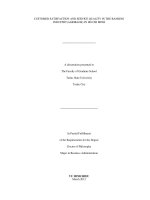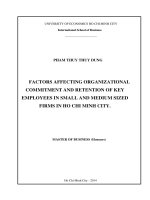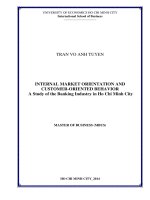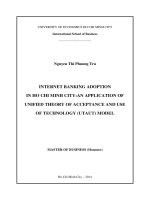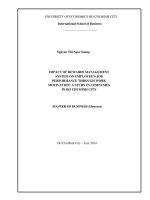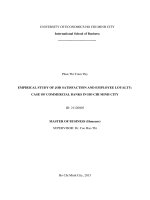Internet banking adoption in ho chi minh city an application of unified theory of acceptance and use of technology (utaut) model
Bạn đang xem bản rút gọn của tài liệu. Xem và tải ngay bản đầy đủ của tài liệu tại đây (619.96 KB, 92 trang )
UNIVERSITY OF ECONOMICS HO CHI MINH CITY
International School of Business
------------------------------
Nguyen Thi Phuong Tra
INTERNET BANKING ADOPTION
IN HO CHI MINH CITY:AN APPLICATION OF
UNIFIED THEORY OF ACCEPTANCE AND USE
OF TECHNOLOGY (UTAUT) MODEL
MASTER OF BUSINESS (Honours)
Ho Chi Minh City – 2014
UNIVERSITY OF ECONOMICS HO CHI MINH CITY
International School of Business
------------------------------
Nguyen Thi Phuong Tra
INTERNET BANKING ADOPTION
IN HO CHI MINH CITY: AN APPLICATION OF
UNIFIED THEORY OF ACCEPTANCE AND USE
OF TECHNOLOGY (UTAUT) MODEL
ID: 22110065
MASTER OF BUSINESS (Honours)
SUPERVISOR: Dr. NGUYEN THI NGUYET QUE
Ho Chi Minh City – 2014
ACKNOWLEDGMETS
Firstly, I would like to express my deepest appreciation to my supervisor Dr. Nguyen
Thi Nguyet Que for her professional guidance, valuable advice, continuous
encouragement, and motivating support that made this thesis possible.
I would like to extend deep senses of gratitude to Professor Nguyen Dong Phong, Dr.
Tran Ha Minh Quan, Professor Nguyen Dinh Tho and lecturers who have taught and
me valuable knowledge and experience during the period of Master of Business
course at International School of Business.
Special, thanks to all of my dear friends in MBUS 2011 class, who share with me
useful material, response and experience to conduct this study.
I would like to express my grateful thanks to my friends and all the customersin three
banking who participated in filling the questionnaires and provided the valuable
information for this study.
Personally, I wish to express my deep gratitude to my parents, my husband and two
younger brothers for their spiritual support and encouragement during the time of
study. Specially, I must express my gratitude to Cao Thi Ngoc Anh, mother - in - law,
for her taking care of my son since I was pregnant until now when my child is 17
months old. So, I was able to complete the course on time. I also wish to thank all
those people who spent their time and generous support making this thesis project a
dream come true.
Ho Chi Minh City, Vietnam,
21 April 2014
Nguyen Thi Phuong Tra
i
PLAGIARISM STATEMENTS
I would like to declare that, apart from the acknowledged references, this thesis either
does not use language, ideas, or other original material from anyone; or has not been
previously submitted to any other educational and research programs or institutions. I
fully understand that any writings in this thesis contradicted to the above statement
will automatically lead to the rejection from the MBA program at International School
of Business University of Economics, HCMC.
ii
COPYRIGHT STATEMENT
This copy of the thesis has been supplied on condition that anyone who consults it is
understood to recognize that its copyright rests with its author and that no quotation
from the thesis and no information derived from it may be published without the
author’s prior consent.
© Nguyen Thi Phuong Tra / ISB-MBUS/2011-2013
iii
ABSTRACT
Purpose: Internet banking is becoming a new focuses as the number of Internet users
and its benefits is increasing worldwide and its benefits. However, the degree of intent
to use Internet marketing is still a question of interest. Thus, the purpose of this paper
is to investigate the effects of performance expectancy, effort expectancy, social
influence, facilitating conditions, perceived credibilityand anxiety on behavioural
intention to use Internet banking in Viet Nam and the developing Asian countries with
good internet infrastructure. Totally, 300 questionnaires were distributed to customers
of Bank for Investment and Development of Viet Nam (BIDV), Asia commercial
bank
(ACB)
and
Military Commercial
Joint
Stock
Bank
(MBBank),278
questionnaires were collected and 242 questionnaires were used for the final analysis.
The results from analysis of them based on multiple linear regression show that all
five factors i.e. performance expectancy, social influence, facilitating conditions,
perceived credibilityand anxietyhave an impact on behavioural intention to use
Internet banking. Knowing the determinants on Internet banking adoption could help
banking companies to improve their service to attract more users. Besides, the use of
Internet banking could reduce the frequency to bank that indirectly reduces cost.
Keywords: Internet banking, performance expectancy, effort expectancy, social
influence, facilitating condition, perceived credibilityand anxiety.
iv
TABLE OF CONTENT
---o0o--ACKNOWLEDGMETS .................................................................................................. i
COPYRIGHT STATEMENT .......................................................................................iii
ABSTRACT .................................................................................................................. iv
TABLE OF CONTENT.................................................................................................. v
LIST OF TABLES......................................................................................................... ix
LIST OF ABBREVIATIONS ........................................................................................ x
1.
CHAPTER 1: INTRODUCTION ....................................................................... 1
1.1
Research background........................................................................................... 1
1.2
Problem statement ............................................................................................... 2
1.3
Research objective ............................................................................................... 3
1.4
Research scopes and methodology ...................................................................... 4
1.5
Thesis structure .................................................................................................... 5
2.
CHAPTER 2: LITERATURE REVIEW AND HYPOTHESIS ......................... 7
2.1
Theoretical foundation......................................................................................... 7
2.1.1 The Theory of Reasoned Action (TRA) ............................................................. 7
2.1.2 Theory of Planned Behavior (TPB) .................................................................... 8
2.1.3 Technology Acceptance Model (TAM) .............................................................. 9
2.2
The Unified Theory of Acceptance and Use of Technology (UTAUT) ........... 10
2.3
Development of research hypotheses ................................................................ 12
2.3.1 Performance expectancy ................................................................................... 13
2.3.2 Effort expectancy .............................................................................................. 14
2.3.3 Social influence ................................................................................................. 14
2.3.4 Facilitating conditions ....................................................................................... 16
v
2.3.5 Perceived credibility.......................................................................................... 17
2.3.6 Anxiety .............................................................................................................. 18
2.3.7 Behavioral intention to use Internet banking .................................................... 19
2.4
Summary of research model and hypotheses .................................................... 19
2.5
Summary............................................................................................................ 21
3.
CHAPTER 3: RESEARCH METHODOLOGY............................................... 22
3.1
Research design process .................................................................................... 22
3.2
Development of questionnaires ......................................................................... 23
3.2.1 Measurement scale ............................................................................................ 23
3.2.2 Draft questionnaires .......................................................................................... 25
3.3
Pilot study .......................................................................................................... 25
3.4
Main survey ....................................................................................................... 26
3.4.1 Sample size ........................................................................................................ 26
3.4.2 Sampling method .............................................................................................. 27
3.5
Data analysis method ......................................................................................... 28
3.5.1 Reliability .......................................................................................................... 29
3.5.2 Exploratory factor analysis (EFA) .................................................................... 29
3.5.3 Multiple regression analysis .............................................................................. 30
3.6
Summary............................................................................................................ 31
4.
CHAPTER 4: DATA ANALYSIS .................................................................... 32
4.1
Descriptive data analysis ................................................................................... 32
4.2
Reliability analysis ............................................................................................ 34
4.3
Exploratory factor analysis (EFA) .................................................................... 37
4.3.1 Exploratory factor analysis results for measurement scales of independent
factors ........................................................................................................................... 37
vi
4.3.2 EFA analysis results for measurement scales of dependent factors (behavioral
intention to use Internet banking) ................................................................................. 40
4.4
Correlation and regression ................................................................................. 41
4.4.1 Correlation analysis ........................................................................................... 41
4.4.2 Regression assumption testing .......................................................................... 43
4.4.3 Multiple linear regression analysis (MLR) ....................................................... 44
4.5
Final research model.......................................................................................... 48
4.6
Summary............................................................................................................ 49
5.
CHAPTER 5: CONCLUSIONS AND IMPLICATIONS ................................. 50
5.1
Conclusions of research ..................................................................................... 50
5.2
Research contribution ........................................................................................ 52
5.3
Managerial implications .................................................................................... 53
5.4
Limitations and recommendations for future research ...................................... 56
REFERENCES ............................................................................................................. 58
APPENDICES .............................................................................................................. 65
Appendix A: Summarizes the Unified Theory of Acceptance and Use of Technology
(UTAUT) model. .......................................................................................................... 65
Appendix B: Guidelines for in-depth interview. .......................................................... 67
Appendix C: List of interviewers ................................................................................ 69
Appendix D: Questionnaire (English Version) ............................................................ 70
Appendix E: Questionnaire (Vietnamese Version) ...................................................... 72
Appendix F: Results of EFA testing for independent variables ................................... 74
Appendix G: Results of EFA testing for dependent variables ..................................... 76
Appendix H: Multiple regression analysis ................................................................... 77
vii
LIST OF FIGURES
Figure 2.1: Theory of Reasoned Action from Fishbein and Ajzen (1975,1980) ........... 8
Figure 2.2: Theory of Planned Behavior (Ajzen, 1985) ................................................ 9
Figure 2.3: Technology Acceptance Model (Davis et al, 1989).................................. 10
Figure 2.4: Unified Theory of Acceptance and Use of Technology (Venkatesh et al.,
2003) ............................................................................................................................. 12
Figure 2.5: The proposed research model with hypotheses ........................................ 19
Figure 3.1: Research procedure ................................................................................... 22
Figure 4.1: Final research model ................................................................................. 49
viii
LIST OF TABLES
Table 3.1: Construct and corresponding items ............................................................ 23
Table 4.1: Mode of data collection .............................................................................. 32
Table 4.2: Type of gender ............................................................................................ 33
Table 4.3: Type of age ................................................................................................. 33
Table 4.4: Type of education ....................................................................................... 34
Table 4.5: Type of income ........................................................................................... 34
Table 4.6: Reliability analysis result............................................................................ 36
Table 4.7: KMO and Bartlett's test of independent variables ...................................... 37
Table 4.8: Rotated component matrix of independent................................................. 38
Table 4.9: KMO and Bartlett’s test of dependent variables ........................................ 40
Table 4.10: Total variance explained ........................................................................... 40
Table 4.11: Rotated component matrix of dependent variable .................................... 40
Table 4.12: Correlations analysis ................................................................................ 42
Table 4.13: Model summary of multiple linear regression analysis ............................ 45
Table 4.14: ANOVA of multiple linear regression analysis........................................ 45
Table 4.15: Coefficient of multiple linear regression analysis .................................... 46
Table 4.16: Hypothesis summary ................................................................................ 48
ix
LIST OF ABBREVIATIONS
ACB
Asia Commercial Bank
AN
Anxiety
BIDV
Bank for Investment and Development of Viet Nam
EE
Effort Expectancy
EFA
Exploratory Factor Analysis
FC
Facilitating Conditions
IBS
Internet Banking Services
HCMC
Ho Chi Minh City
KMO
Kaiser-Meyer-Olkin
OBS
Online Banking Services
MBBANK
Military Commercial Joint Stock Bank
PC
Perceived Credibility
PE
Performance Expectancy
SI
Social Influence
TAM
Technology Acceptance Model
TPB
Theory of Planned Behavior
TRA
Theory of Reasoned Action
UTAUT
Unified Theory of Acceptance and Use of Technology
x
1.
1.1
CHAPTER 1: INTRODUCTION
Research background
Internet banking is an innovative service, which has been perpetuated by the
development and diffusion of the Internet communication technology. Internet banking
services not only allow customers to carry out a range of banking activities such as
managing bank accounts and transactions without leaving their desks (Weir et al., 2006),
but also a very cost-efficient way for banks to provide their customer services (Yakhlef,
2001).
Internet banking offers customers the advantages of lower costs, location and time
convenience, the ease and speed of completing transactions. As one percent increase in
the retention of Internet banking acceptance will typically bring 18 percent reduction in
operating cost (Bhattacherjee, 2001), indifference towards consumers’ adoption of
Internet banking services may result in a big loss to the financial institutions. Therefore,
the development of Internet banking services is most important in bank management.
From year 2000 to 30 June 2012, the total Internet user growth is 566.4%
worldwide. The largest proportion (44.8%) of Internet users was from Asia followed by
Europe (21.5%) and North America (11.4%). Viet Nam, an Asian country was among the
Top 20 highest number of Internet users from 2010 to 30 June 2012. In year 2000, Viet
Nam Internet users recorded 200,000 and increased to 31,034,900 in June, year 2012.
This showed an increase of 155 times in 12 years (Internet World Stats, 2012).
Internet banking was first launch by Viet Nam in may, 2002 to provide Internet
banking services to bank holders. According to the commercial banks survey of Nielsen
Global in 2012, there is less than 1.02% banking customers using Internet banking
1 | Page
services. This rate is very low if compared with the number of Internet subscribers
nationwide at the end of June 2012. This figure is also still very low when compare with
developed nations in Asia. It means that Internet banking service in Viet Nam is a
potential market in future. Hence, the need to understand the factors influencing to use
Internet banking services is indispensable.
1.2
Problem statement
The Internet banking plays a significant role in the Banking industry. According to
Yasuharu(2003), implementation of information technology and communication
networking has brought about a revolution in the functioning of the banks and the
financial institutions.The transition to electronic banking has therefore become a
necessity for banks as it offers major opportunities in terms of competitive advantage and
it also allows banks to develop a stronger and more durable business relationship with its
customers.
However, despite of the numerous benefits, the acceptance of Internet banking in
Vietnam is relatively low when comparing to West and the United States. In Asian
region, most studies concentrated to developed Asian countries (Singapore, Hong Kong,
Taiwan, Malaysia, ect...) than developing country like Vietnam in the last twenty
years.Thus, understanding the reason for acceptance or non-acceptance of new
technologies by people is one of the greatest challenges. Hence, there is a necessity to
research about the behavioral intention to use Internet banking in Ho Chi Minh City, Viet
Nam.That is also the motivation for developing this research.
Most studies focused narrowly on the positiveaspects of Internet banking services.
For example, AbuShanab and Pearson (2009) focused on the effects of trust, relative
advantage and attitude toward using Internet banking services. Additional dimensions
2 | Page
were added to the UTAUT model such as voluntariness of use (Anderson and Schwager,
2004);perceived credibility and anxiety (Yeow et al., 2008), self-efficacy, anxiety,
perceived trust, perceived risk, personal innovativeness and locus of control (AbuShanad
and Pearson, 2009); trust (Foon and Fah, 2011). On the other hand, the research’s
findings of Yeow et al. (2008)have proved that perceived credibility and anxiety add to
the UTAUT model in Malaysia. This is market that posses many similar traits to
Vietnam’s market. Moreover, the motivation of this study also derives from the lack of
studies in terms of Internet banking in Vietnam from the UTAUT model. There are very
few studies, for examples, the research of Khuu and Nguyen (2011)showed that
performance expectancy, social influence, perceived credibility and anxiety significantly
impact customers’ intention to adopt Internet banking. In addition, effort expectancy and
self-efficacy do not affect the intention to use Internet banking.
Therefore, this study aims to test the influences of UTAUT model (performance
expectancy, effort expectancy, social influence, facilitating conditions) and two
additional dimensions(perceived credibility and anxiety) on behavioral intention to use
Internet bankingin Ho Chi Minh City, Viet Nam.This issue is important because the
results help the banks with marketing strategies encourage customers to use Internet
banking in the future.
1.3
Research objective
The objectives of this study are to investigate and confirm the factors affecting
behavioral intention to use Internet banking in Ho Chi Minh City, Viet Nam. The study
will investigate these factors usingUTAUT models. More specifically, it aims to:
3 | Page
- Examine the impact of performance expectancy on behavioral intention to use
Internet banking.
- Examine the impact of effort expectancy on behavioral intention to use Internet
banking.
- Examine the impact of social influence on behavioral intention to use Internet
banking.
- Examine the impact of facilitating conditions on behavioral intention to use
Internet banking.
- Examine the impact of perceived credibility on behavioral intention to use
Internet banking.
- Examine the impact of anxiety on behavioral intention to use Internet banking.
1.4
Research scopes and methodology
This study was conducted in Ho Chi Minh City, the largest economic center of
Vietnam. Sample of study is the customersthat have bank accounts and understand about
Internet banking servicesbut do not use Internet banking services. Time and cost
restricting, a database of three banks including Bank for Investment and Development of
Viet Nam (BIDV), Asia Commercial Bank (ACB) and Military Commercial Joint Stock
Bank (MBBank)
The study design into two phases: first was qualitative phase (in-depth interview),
second was quantitative phase (main survey). In-depth interviews are conducted with ten
people. Main study is quantitative research with sample size of 300 respondents.The next
step is analyzing the collected data. The data of this research is processed using SPSS
22.0 software with three main stages. First, Cronbach’s alpha method will be used to test
4 | Page
reliability of the measurement scale. Then, Explore Factor Analysis (EFA) will be used to
test validity of the measurement scale and for data reduction purpose. Final, Multiple
Linear Regression(MLR) will be used to test the relationship between variables in this
research model.
1.5
Thesis structure
The content of this study is 05 chapters. The first is the introduction of the study.
The second is the literature review and hypotheses. Following is the research
methodology. The next part is data analysis. The final chapter is conclusions and
implications is discussion of research findings and recommendations for future research
comprise the final section of this research.
Chapter 1 – Introduction
This chapter reflects the current situation of Internet banking services in Vietnam.
It leads to proposal for the research problem, research objectives, research scope and
significance of this study also presented in this section.
Chapter 2 – Literature review
This chapter focuses on explaining each variable in the model and the reasons for
their selection. Moreover this chapter will show information about the model and
hypothesis will be tested in this research.
Chapter 3 – Research methodology
The study design, development of survey questions, qualitative research. The
measurement scale factor applied to the study will be clearly identified. Also, determine
5 | Page
how to collect data and analyze the data collected to test the hypotheses proposed in
chapter 2.
Chapter 4 – Data analysis
This section discussed the data collection methods used to test hypotheses, and
analyze the data received, the reliability and multiple regressions.
Chapter 5 –Conclusion and implications
This chapter includes the conclusions and managerial implications. The limitations
are recognized to direct in the future. Lastly, thesis has proposed further research on the
subject area.
6 | Page
2.
CHAPTER 2: LITERATURE REVIEW AND HYPOTHESIS
Before carrying out the survey on the effect factors of behavioral intention to use
Internet banking, this chapter provides a theoretical background about Unified Theory of
Acceptance and Use of Technology model (UTAUT). Based on these, the conceptual
research model and hypotheses are constructed.
2.1
Theoretical foundation
The technology acceptance literature documents a rich collection of models and theories
that could be used to explain the adoption of information technology innovations
(Venkatesh et al., 2003). To understand technology adoption, Venkatesh et al. (2003)
empirically compared eight competing models named:the Theory of Reasoned Action
(TRA), the Theory of Planned Behavior (TPB), the Technology Acceptance Model
(TAM), the Model of PC Utilization (MPCU), the Motivation Model (MM), the
Innovation Diffusion Theory (IDT), the Social Cognitive Theory (SCT) and a combined
model of TAM and TPB (C-TAM- TPB) in Appendix A summarizes these
models.Examples of some of the most influential models include the theory of reasoned
action (TRA); the theory of planned behavior (TPB), the technology acceptance model
(TAM) (El-Gayar, O., Moran, M., & Hawkes, M., 2011).
2.1.1 The Theory of Reasoned Action (TRA)
The Theory of Reasoned Action developed by Fishbein and Ajzen (1975, 1980)
derived from previous research that started out as a theory of attitude, which led to the
study of attitude and behavior. The Theory of Reasoned Action is a model for the
prediction of behavioral intention, spanning predictions of attitude and predictions of
7 | Page
behavior. The components ofTRA are three general constructs: behavioral intention(BI),
attitude toward behavior(A): “an individual’s positive or negative feelings (evaluative
affect) about performing the target behavior” (Fishbein and Ajzen, 1975, p.216), and
subjective norm(SN): “the person’s perception that most people who are important to him
think he should or should not perform the behavior in question” (Fishbein and Ajzen,
1975, p.302).
Figure2.1: Theory of Reasoned Action (Ajzen& Fishbein, 1975)
Beliefs and
Evaluations
Attitude Toward
Behavior
Behavioral
Intention
Normative Beliefs
and Motivation
Actual Behavior
Subjective Norm
TRA suggests that a person's behavioral intention depends on the person's attitude
about the behavior and subjective norms (BI = A + SN). If a person intends to do a
behavior then it is likely that the person will do it.
2.1.2 Theory of Planned Behavior(TPB)
The Theory of Planned Behavior builds on the TRA(Ajzen, 1985). The Theory of
Planned Behavior is a theory predicts deliberate behavior, because behavior can be
deliberative and planned. TPB is well - established and proven in both social science and
information technology literature to explain and predict user behavioral intentions
(Mykytyn and Harrison, 1993). The factors that determine intention are the individual’s
attitude toward the behavior (A), the subjective norm (SN) and perceived behavior
8 | Page
control (PBC). Perceived behavior control is “the perceived ease of difficulty of
performing the behavior” (Ajzen 1991,p.188).
Figure2.2: Theory of Planned Behavior (Ajzen& Fishbein, 1985)
Behavioral
Beliefs
Attitude
Normative Beliefs
Subjective Norm
Control Beliefs
Perceived
Behavioral
Control
Behavioral
Intention
Behavior
According to The Theory of Planned Behavior (TPB) intention is not only affected
by two factors that are subjective attitudes and standards but also by the third factor - the
perceived behavioral control. The perceived behavioral control represents the resources
needed by a person to perform any work, referring to the available resources, the skills,
opportunities and perceptions of each who aim to achieve results. TPB model is
considered a more optimal TRA model in predicting and explaining consumer behavior
in the context of content and research.
2.1.3 Technology Acceptance Model (TAM)
Technology Acceptance Model model was builtby Fred Davis and Richard
Bagozzi(Bagozzi et al.,1992; Davis, 1989). This model is derived from TRA and TPB in
the field of electronic banking in the country. TAM proposes a model to explain why a
user accepts or reject information technology (Davis, 1989 and Davis et al., 1989). TAM
focuses on explaining behavior intention to use a specific technology or service; it has
become a widely used model for user acceptance and use.
9 | Page
Figure2.3: Technology Acceptance Model (Davis et al, 1989)
External
variables
Perceived
Ease of use
Attitude
Intention to
use
Use
Perceived
Usefulness
TAM model is used for the use of a new technology (Davis, 1989). Compared
with previous TRA and TPB, TAM is the model most commonly used to explain the
behavior of the system used, particularly the field of E-banking.
- Perceived ease of use: The degree to which a person believes that using a particular
system would be free from effort.
- Perceived usefulness: The degree to which a person believes that using a particular
system would enhance his or her job performance.
Studies comparing TRA and TPB showed the latter to be a better predictor of
behavioral intention (Ajzen & Madden, 1986). Empirical results found that both TPB and
TAM exhibited considerable predictive power for adoption intentions, while TAM could
predict attitude better than TPB (Mathieson, 1991). TAM when compared with TRA, also
explained a larger variance in adoption intentions (Davis et al., 1989).
2.2
The Unified Theory of Acceptance and Use of Technology (UTAUT)
Towards the development of UTAUT by Venkatesh et al. (2003), Theory of
Reasoned Action (TRA) by Fishbein and Ajzen (1975), Technology Acceptance Model
(TAM) by David (1989), Theory of Planned Behavior (TPB) by Ajzen (1991) and the
combined TAM and TPB (C-TAM-TPB) by Taylor and Todd (1995) were used.
10 | Page
Moreover, Theory of Diffusion of Innovation (DOI) by Rogers (1995), Social Cognitive
Theory (SCT) by Bandura (1986), Motivational Model (MM) by Davis et al. (1992) and
the Model of PC Utilization (MPCU) by Thompson et al. (1991) were also used.
Meanwhile, Venkatesh et al. (2003) derived four main determinants of behavioral
intentionand usage as performance expectancy, effort expectancy, and social influence.
Besides, empirical results of UTAUT model shows that it account for 70% of variance in
the usage intention, which make it supersede other antecedent models of UTAUT.
Unified Theory of Acceptance and Use of Technology model four key constructs
(performance expectancy, effort expectancy, social influence, and facilitating conditions)
are direct determinants of usage intention and behavioral intention (Venkatesh et al.,
2003).
- Performance Expectancy (PE):the extent to which an individual believes that
using the system will help them achieves high performance work (Venkatesh et al.,
2003).The constructs in the other models that pertain to performance expectancy are:
perceived usefulness (TAM, and combined TAM-TPB).
- Effort expectancy: The degree of ease associated with the use of the system
(Venkatesh et al., 2003). The constructs in the other models that capture the same concept
are perceived ease-of-use (TAM/TAM2)
- Social influence: The degree to which an individual perceives that important
others believe he or she should use the new system (Venkatesh et al., 2003). Similar
constructs are represented in existing models: subjective norms (TRA, TAM2,
TPB/DTPB, and combined TAM-TPB).
11 | Page
- Facilitating conditions: The degree to which an individual believes that an
organizational and technical infrastructure exists to support use of the system (Venkatesh
et al., 2003). This definition captures three different constructs in existing models:
perceived behavioral control (TPB/DTPB and combined TAM-TPB) and facilitating
conditions (MPCU).
Figure2.4: Unified Theory of Acceptance and Use of Technology(Venkatesh et al., 2003)
Performance
expectancy
Effort
Expectancy
Behavioral
Intention
Social
Influence
Use Behavior
Facilitating
Conditions
Gender
2.3
Age
Experience
Voluntariness of
use
Development of research hypotheses
Because UTAUT has been empirically tested and proven superior to other
prevailing competing models (Venkatesh et al., 2003; AbuShanab & Pearson, 2009;
Yeow et al., 2008; Venkatesh & Zhang 2010; Foon & Fah 2011), this study chooses
UTAUT as a theoretical foundation to develop the hypotheses.
Based on the literature review, Unified Theory of Acceptance and Use of
Technology, this research proposes the research model indicated in Figure 2.5, including
the six factors that have impact on behavioral intention to use Internet banking.
Fourfactor oforiginal UTAUT model including performance expectancy, effort
12 | Page
expectancy, social influence, and facilitating conditionsare from Venkatesh et al.(2003).
Two additional dimensionsperceived credibility and anxietyadapted from Yeow et al.
(2008).
2.3.1 Performance expectancy
The first independent variable, performance expectancy can be defined as user
perception that a technology can increase productivity (Raman & Don, 2013). It reflects
the assessment of the benefits received when initiatives are accepted or use. Internet
banking offers many benefits to customers as customers can perform many financial
transactions. Moreover, accessibility is an important aspect associated with the
performance expectancy of Internet banking (Polatoglu& Ekin, 2001; Raman& Don,
2013). As discovered by Polatoglu & Ekin(2001), the Internet enables users to visit an
online banking website at any time and from any location more easily and efficiently. In
comparison with traditional banking, Internet banking is able to reach far more people
and keep away people from waiting in lines. So, customers feel the work efficiency
improved by the time-saving and convenience. In other words, this study expect
customers aware of Internet banking provided to these utilities, customers have a positive
attitude with this technology.
In this study’s context, performance expectancy refers to the belief that by using
Internet marketing will help users gain benefits such as increased productivity, efficiency,
and time saving.The previous studies in the field of Internet banking also confirmed that
performance expectancy was a significant positive relationship with behavioral intention
to use Internet banking(AbuShanab& Pearson, 2009; Yeow et al., 2008; Foon & Fah,
2011).This study expects that performance expectancy will have a significant determinant
of behavioral intention to use Internet banking. Thus, the following hypothesis H1:
13 | Page


